1998 GMC SAVANA seats
[x] Cancel search: seatsPage 48 of 388

Lap Belt
If your vehicle has rear bench seats, someone can sit in
the center positions.
When you sit
in a center seating position, you have a lap
safety belt, which has
no retractor. To make the belt
longer, tilt the latch plate and
pull it along the belt.
To make the belt shorter, pull its free end as shown until
the belt is snug.
Buckle, position and release it the same way as the lap
part of
a lap-shoulder belt. If the belt isn’t long enough,
see “Safety Belt Extender” at the end of this section.
Make sure the release button on the buckle is positioned
SO YOU would be able to unbuckle the safety belt quickly
if you ever had to.
1-40
1
ProCarManuals.com
Page 55 of 388
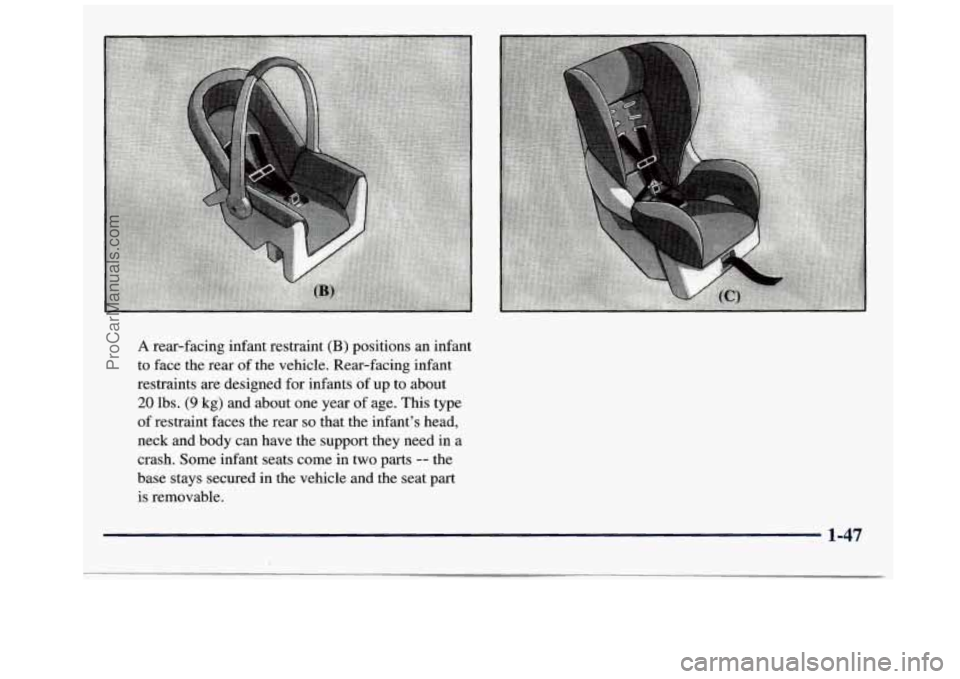
A rear-facing infant restraint (B) positions an infant
to face the rear of the vehicle. Rear-facing infant
restraints are designed for infants
of up to about
20 lbs. (9 kg) and about one year of age. This type
of restraint faces the rear
so that the infant’s head,
neck and body can have the support they need in a
crash. Some infant seats come in two
parts -- the
base stays secured in the vehicle and the seat part
is removable.
1-47
ProCarManuals.com
Page 57 of 388
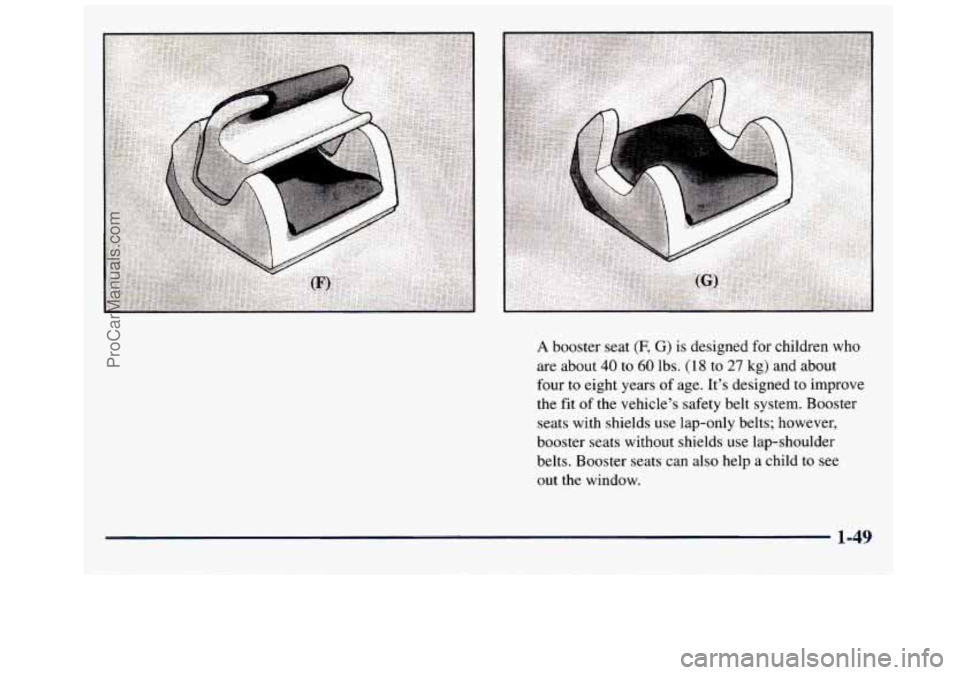
A booster seat (F, G) is designed for children who
are about
40 to 60 lbs. (18 to 27 kg) and about
four to eight years of age. It’s designed to improve
the fit of the vehicle’s safety belt system. Booster
seats with shields use lap-only belts; however,
booster seats without shields use lap-shoulder
belts. Booster seats can
also help a child to see
out the window.
1-49
ProCarManuals.com
Page 64 of 388
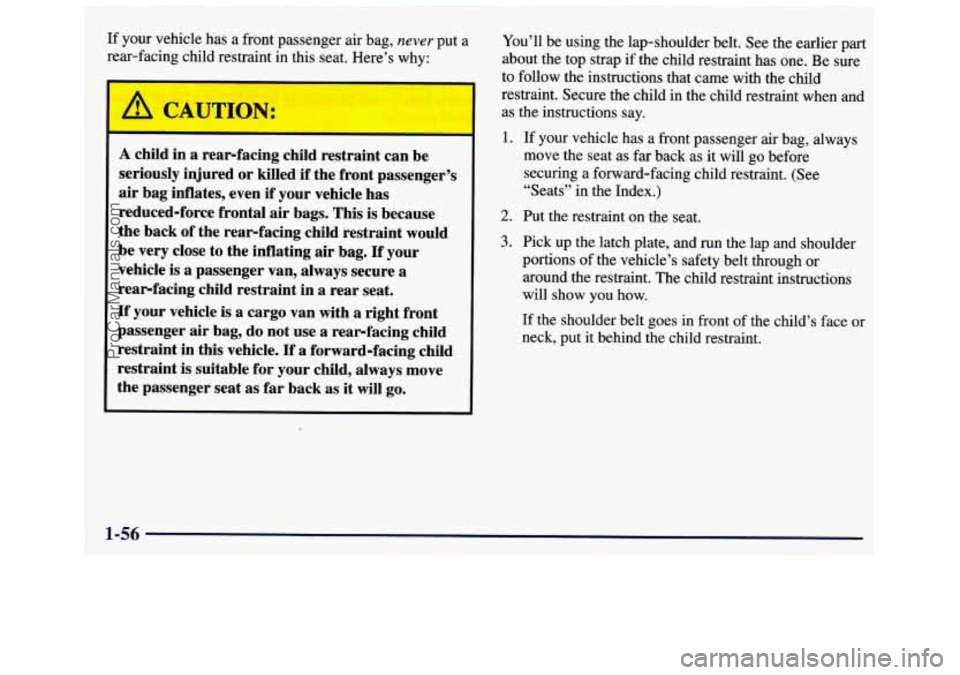
If your vehicle has a front passenger air bag, never put a
rear-facing child restraint
in this seat. Here’s why:
-
A child in a rearfacing child restraint can be
seriously injured or killed if the front passenger’s
air bag inflates, even if your vehicle has
reduced-force frontal air bags. This is because
the back
of the rearfacing child restraint would
be very close to the inflating air bag.
If your
vehicle is a passenger van, always secure a
rearfacing child restraint in a rear seat.
If your vehicle is a cargo van with a right front
passenger air bag, do not use a rearfacing child
restraint in this vehicle.
If a forward-facing child
restraint is suitable for your child, always move
the passenger seat as far back as it
will go.
You’ll be using the lap-shoulder belt. See the earlier part
about the top strap if the child restraint has one. Be sure
to follow the instructions that came with the child
restraint. Secure the child in the child restraint when and
as the instructions say.
1. If your vehicle has a front passenger air bag, always
move the seat as far back as it will
go before
securing a forward-facing child restraint. (See
“Seats” in the Index.)
2. Put the restraint on the seat.
3. Pick up the latch plate, and run the lap and shoulder
portions of the vehicle’s safety belt through or
around the restraint. The child restraint instructions
will show
you how.
If the shoulder belt goes in front of the child’s face or
neck, put
it behind the child restraint.
‘ 1-56 i
ProCarManuals.com
Page 142 of 388

Air Conditioning Heating
Before using your vehicle’s air conditioning, open the
windows to clear the vehicle
of hot air. This reduces the
time it takes for your vehicle to cool down. Then keep
your windows closed for the air conditioner to work at
its best.
You can use MAX
AIC with the temperature knob in the
blue area when it’s really hot outside and you need to
cool
the inside air quickly. MAX A/C lets in only a little
air from the outside.
If you first
use MAX A/C, you can then use A/C with
the temperature knob in the blue area, as soon as the
vehicle has cooled down,
so outside air will be going
through your vehicle.
If your vehicle has rear air conditioning, setting it on
LO
may enhance front A/C performance by allowing
trapped refrigerant in rear lines to circulate.
When the air conditioning,
DEFROST or BLEND is on,
you may notice a slight increase
or decrease in engine
speed, due to compressor operation. This
is normal
because the system
is designed to cycle the compressor
on and off to keep the desired temperature.
On cold days, use HEATER with the temperature knob
in the red area. Outside air will be brought in through
the floor outlets. The heater works best if you keep your
windows closed while using it.
If you use the optional engine coolant heater before
starting your engine, your heating system will produce
warmer air faster
to heat the passenger compartment in
cold weather. See “Engine Coolant Heater” in the Index.
Ventilation Tips
0
0
0
Keep the hood and front air inlet free of ice, snow, or
any other obstruction (such
as leaves). The heater
and defroster will work
far better, reducing the
chance of fogging
the inside of your windows.
When you
enter a vehicle in cold weather, turn the
blower fan to
HI for a few moments before driving
off. This helps clear the intake ducts of snow and
moisture, and reduces the chance
of fogging the
inside
of your windows.
Keep the air path under the front seats clear of objects.
This helps air
to circulate throughout your vehicle.
Your vehicle has air vents in
the center and on the sides
of your instrument panel.
3-6
ProCarManuals.com
Page 192 of 388
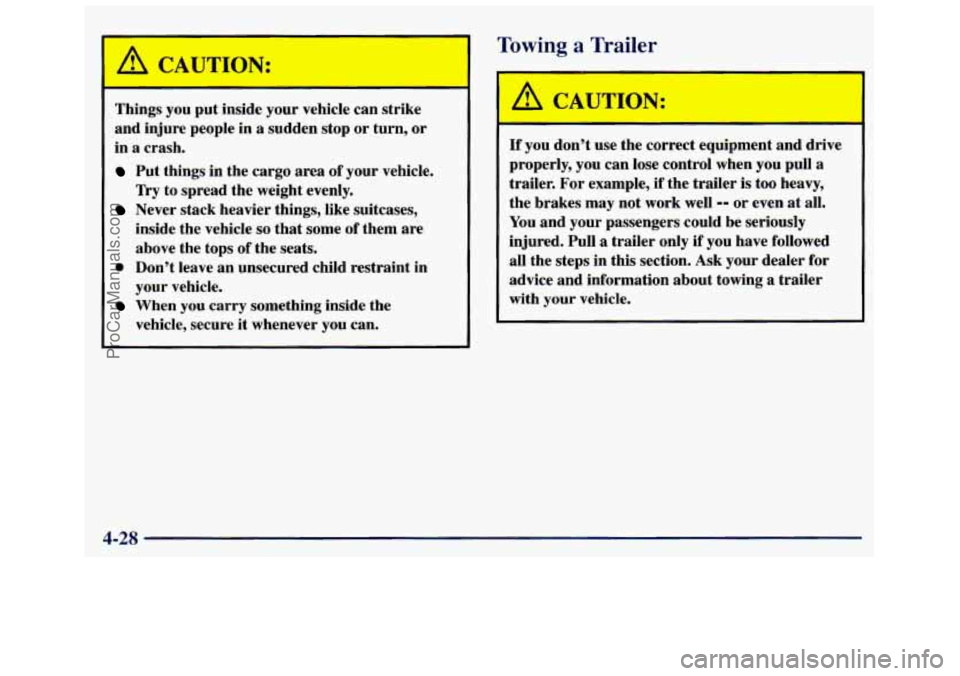
CAUTION:
Things you put inside your vehicle can strike
and injure people in
a sudden stop or turn, or
in a crash.
Put things in the cargo area of your vehicle.
Try to spread the weight evenly.
Never stack heavier things, like suitcases,
inside the vehicle
so that some of them are
above the tops
of the seats.
0 Don’t leave an unsecured child restraint in
your vehicle.
When you carry something inside the
vehicle, secure it whenever you can.
Towing a Trailer
A CAUTION:
If you don’t use the correct equipment and drive
properly, you can lose control when you pull a
trailer. For example,
if the trailer is too heavy,
the brakes may not work well
-- or even at all.
You and your passengers could be seriously
injured. Pull
a trailer only if you have followed
all the steps in this section. Ask your dealer for
advice and information about towing a trailer
with your vehicle.
4-28
ProCarManuals.com
Page 299 of 388
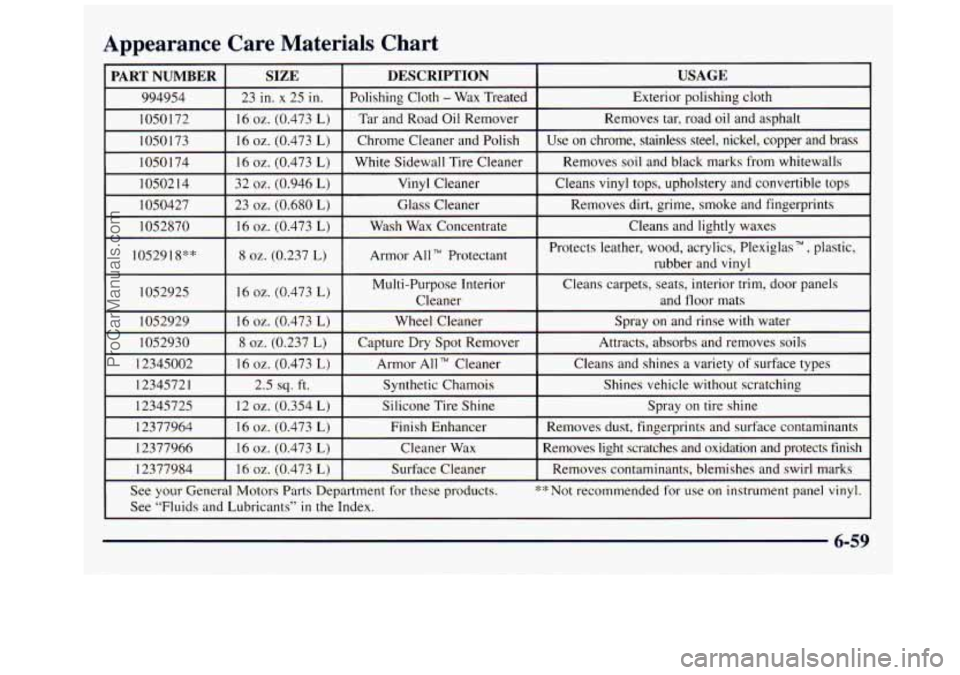
Appearance Care Materials Chart
PART NUMBER SIZE DESCRIPTION USAGE
994954 23 in. x 25 in. Polishing Cloth - Wax
Treated
Exterior polishing cloth
1050172 16
oz. (0.473 L) Tar and Road Oil Remover Removes tar, road oil and asphalt
1050 173 16
oz. (0.473 L) Chrome Cleaner and Polish
Use on chrome, stainless steel, nickel, copper and brass
1050174 16 oz. (0.473 L) White
Sidewall Tire Cleaner Removes soil and black marks from whitewalls
10502 I4 32
oz. (0.946 L) Vinyl Cleaner Cleans vinyl tops, upholstery and
convertible tops
I050427
23 oz. (0.680 L) Glass Cleaner Removes
dirt, grime, smoke and fingerprints
1052870 16
oz. (0.473 L) Wash Wax
Concentrate Cleans
and lightly waxes
I 10529 18”“ I 8 oz. (0.237 L) I Armor All Protectant Protects leather, wood,
acrylics, Plexiglas l‘, plastic,
rubber and vinyl
I 1052925 1 16 oz. (0.473 L) I I
Multi-Purpose Interior Cleans
carpets, seats, interior trim, door panels
Cleaner and floor mats
1052929
16 oz. (0.473 L) Wheel Cleaner
Spray on and rinse with water
1052930
8 oz. (0.237 L) Capture Dry Spot Remover Attracts, absorbs and removes
soils
12345002 16
oz. (0.473 L) Armor All TM Cleaner Cleans
and shines a variety of surface types
1234572
1 2.5 sq. ft. Synthetic Chamois Shines
vehicle without scratching
12345725 12
oz. (0.354 L) Silicone Tire Shine Spray on tire shine
12377964
16 02. (0.473 L) Finish Enhancer Removes dust, fingerprints and surface contaminants
I 12377966 I 16 oz. (0.473 L) I Cleaner Wax I Removes light scratches and oxidation and protects finish
I 12377984 I 16 oz. (0.473 L) I Surface Cleaner I Removes contaminants, blemishes and swirl marks
See your General Motors
Parts Department for these products. **Not recommended for use on instrument panel vinyl.
See “Fluids and Lubricants’’ in the Index.
6-59
ProCarManuals.com
Page 382 of 388
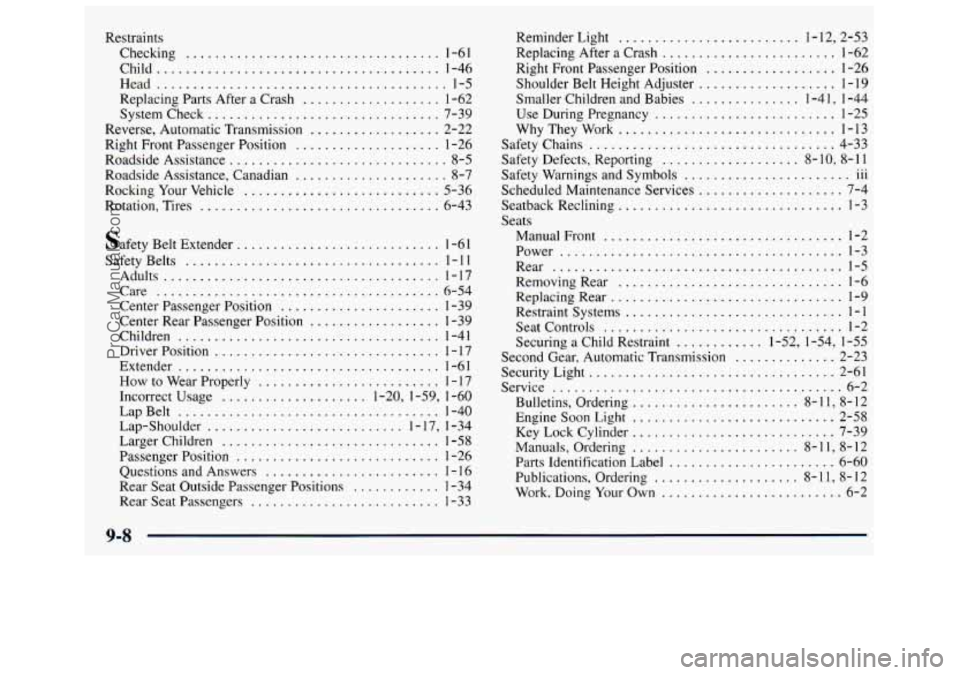
Restraints Checking
................................... 1-61
Child ....................................... 1-46
Head
........................................ 1-5
Replacing Parts After a Crash
................... 1-62
System Check
................................ 7-39
Reverse, Automatic Transmission
.................. 2-22
Right Front Passenger Position
.................... 1-26
Roadside Assistance
.............................. 8-5
Roadside Assistance. Canadian
..................... 8-7
Rocking Your Vehicle
........................... 5-36
Rotation, Tires
................................. 6-43
Safety Belt Extender
............................ 1-61
Safety Belts
................................... 1 . 1 I
Adults ...................................... 1-17
Care
....................................... 6-54
Center Passenger Position
...................... 1-39
Center Rear Passenger Position
.................. 1-39
Children
.................................... 1-41
Driver Position
............................... 1 . 17
Extender
.................................... 1-61
How
to Wear Properly ......................... 1 - 17
Incorrect Usage
.................... 1-20, 1-59, 1-60
LapBelt
.................................... 1-40
Lap-Shoulder
........................... 1-17, 1-34
Larger Children
.............................. 1-58
Questions and Answers
........................ 1 - 16
Rear Seat Passengers
.......................... 1-33
Passenger
Position
............................ 1-26
Rear Seat Outside Passenger Positions
............ 1-34 Reminder
Light
......................... I . 12. 2.53
Replacing After a Crash ........................ 1-62
Right Front Passenger Position
.................. 1-26
Shoulder Belt Height Adjuster
................... 1 . 19
Smaller Children and Babies
............... 1.41. 1-44
Use During Pregnancy
......................... 1-25
WhyTheyWork
.............................. 1-13
Safety Chains .................................. 4-33
Safety Defects. Reporting ................... 8- 10. 8- 11
Safety Warnings and Symbols ....................... 111
Scheduled Maintenance Services .................... 7-4
Seatback Reclining ............................... 1-3
Seats ManualFront
................................. 1-2
Power
....................................... 1-3
Rear
........................................ 1-5
Removing Rear
............................... 1-6
Replacing Rear
................................ 1-9
Restraint Systems
.............................. 1-1
Seatcontrols ................................. 1-2
Securing
a Child Restraint ............ 1-52. 1-54. 1-55
Second Gear. Automatic Transmission
.............. 2-23
Security Light
.................................. 2-61
Service
........................................ 6-2
Bulletins. Ordering
....................... 8-1 1. 8-12
Key Lock Cylinder
............................ 7-39
Parts Identification Label
....................... 6-60
Publications. Ordering
.................... 8- 11. 8- 12
Work. Doing Your Own
......................... 6-2
...
Engine Soon Light ............................ 2-58
Manuals. Ordering
....................... 8- 1 1. 8- 12
9-8
ProCarManuals.com